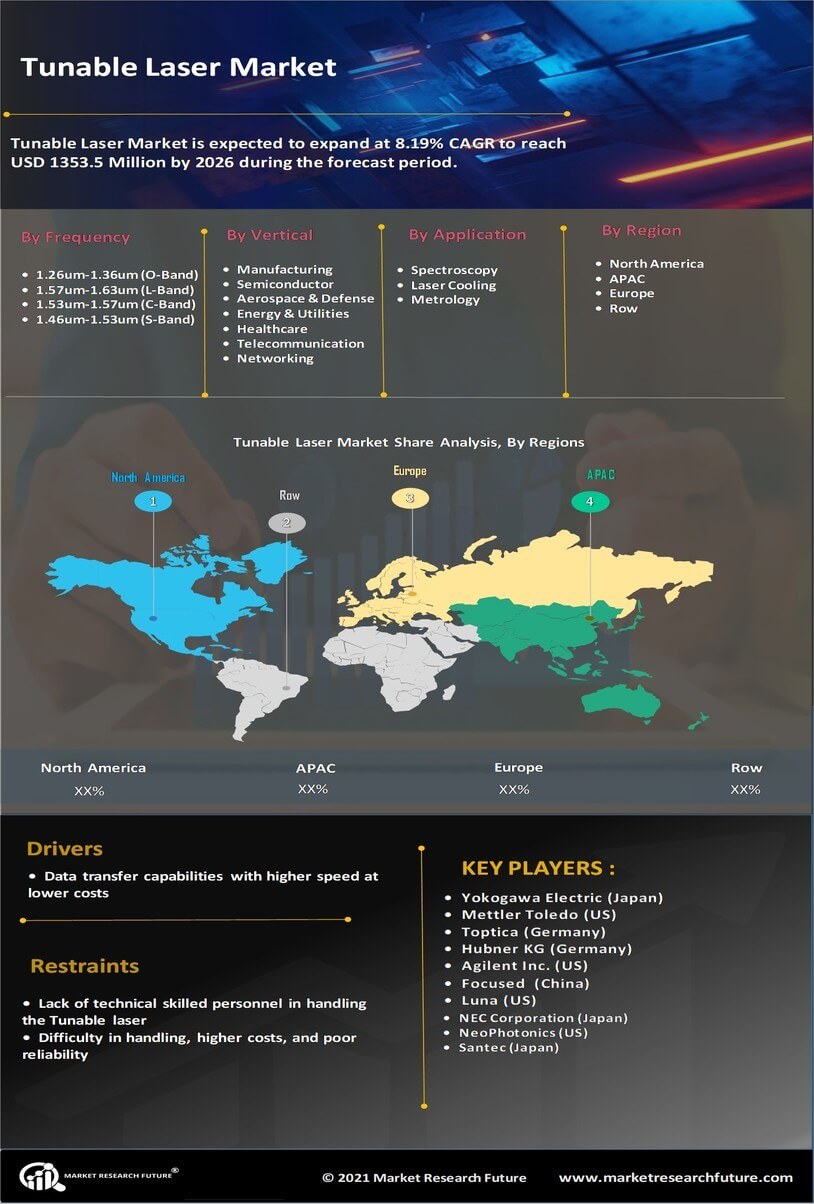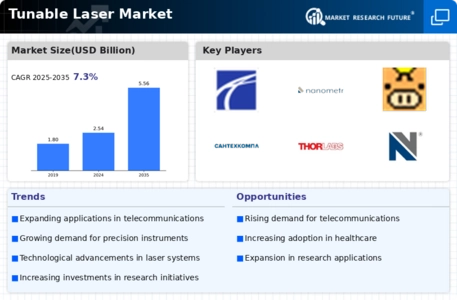Market Growth Projections
The Global Tunable Laser Market Industry is projected to experience substantial growth over the coming years. The market is expected to reach 2.54 USD Billion in 2024 and is anticipated to grow to 5.56 USD Billion by 2035. This growth reflects a compound annual growth rate of 7.38% from 2025 to 2035. Various factors, including advancements in technology, increasing applications across multiple sectors, and rising demand for high-performance laser systems, are likely to drive this expansion. The market's trajectory suggests that tunable lasers will play a pivotal role in future technological advancements, making them a focal point for investment and development.
Advancements in Medical Applications
Innovations in medical technology are significantly influencing the Global Tunable Laser Market Industry. Tunable lasers are increasingly utilized in various medical applications, including laser surgery, diagnostics, and imaging. Their ability to provide precise wavelengths allows for targeted treatments, enhancing patient outcomes. For instance, tunable lasers are employed in procedures such as photodynamic therapy and laser ablation. As healthcare systems worldwide prioritize advanced treatment options, the market is expected to expand. The anticipated growth from 2.54 USD Billion in 2024 to 5.56 USD Billion by 2035 indicates a compound annual growth rate of 7.38% from 2025 to 2035, underscoring the importance of this technology in modern medicine.
Integration with Emerging Technologies
The integration of tunable lasers with emerging technologies is a key driver in the Global Tunable Laser Market Industry. As industries explore applications in areas such as quantum computing, autonomous vehicles, and artificial intelligence, the need for precise and adaptable laser systems becomes evident. Tunable lasers offer the versatility required for these cutting-edge applications, enabling enhanced performance and efficiency. This integration is likely to spur innovation and create new market opportunities. The anticipated growth trajectory, with a market size expected to reach 5.56 USD Billion by 2035, suggests that the synergy between tunable lasers and emerging technologies will be a significant factor in shaping the industry's future.
Growing Demand for Optical Communication
The Global Tunable Laser Market Industry is experiencing a surge in demand driven by the increasing need for high-speed optical communication systems. As data consumption continues to rise, telecommunications companies are investing in advanced technologies to enhance bandwidth and transmission speeds. Tunable lasers, known for their precision and flexibility, are pivotal in this evolution. The market is projected to reach 2.54 USD Billion in 2024, reflecting a robust growth trajectory. This trend is likely to continue as the industry adapts to the growing requirements of 5G networks and beyond, suggesting a sustained demand for tunable laser solutions.
Rising Adoption in Research and Development
The Global Tunable Laser Market Industry is significantly impacted by the increasing adoption of tunable lasers in research and development sectors. These lasers are essential tools in various scientific fields, including physics, chemistry, and materials science, where precise wavelength tuning is crucial for experiments. Research institutions and universities are investing in advanced laser technologies to facilitate innovative studies and breakthroughs. This trend is likely to drive market growth as the demand for high-performance lasers in experimental setups continues to rise. The projected increase in market size from 2.54 USD Billion in 2024 to 5.56 USD Billion by 2035 reflects the critical role of tunable lasers in advancing scientific knowledge.
Environmental Monitoring and Sensing Applications
The Global Tunable Laser Market Industry is witnessing growth due to the increasing demand for environmental monitoring and sensing applications. Tunable lasers are employed in various environmental sensing technologies, including gas detection and atmospheric studies. Their ability to provide precise measurements of specific wavelengths makes them ideal for monitoring pollutants and greenhouse gases. As governments and organizations worldwide emphasize environmental protection and sustainability, the adoption of advanced sensing technologies is likely to rise. This trend could contribute to the market's expansion, with projections indicating a growth from 2.54 USD Billion in 2024 to 5.56 USD Billion by 2035, highlighting the relevance of tunable lasers in addressing environmental challenges.

















Leave a Comment